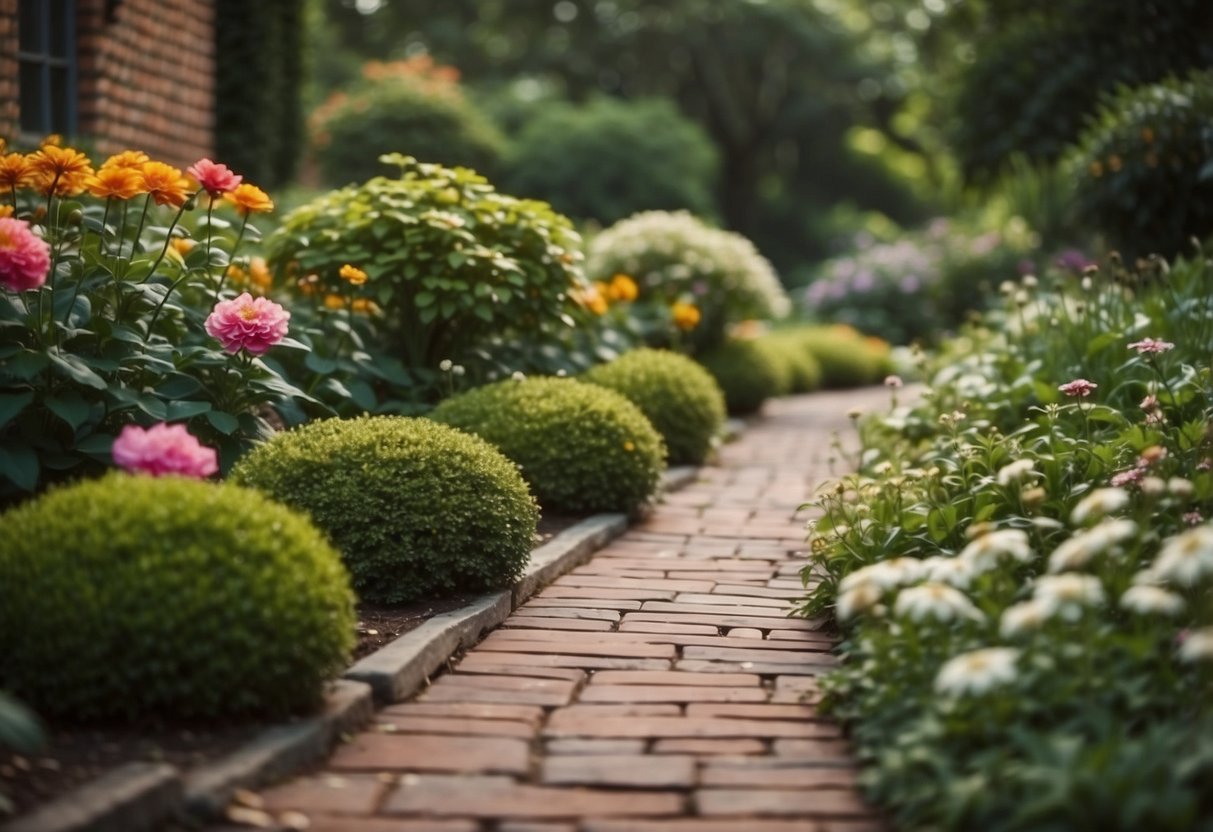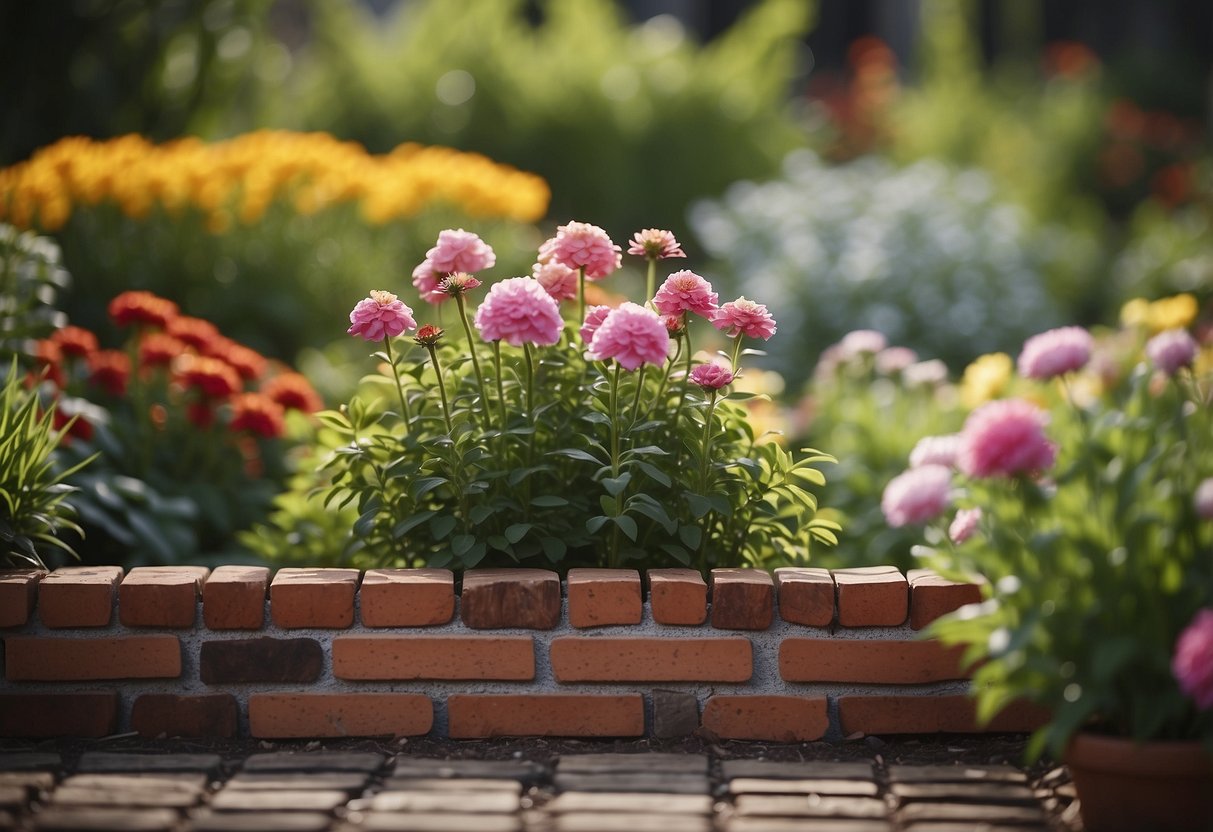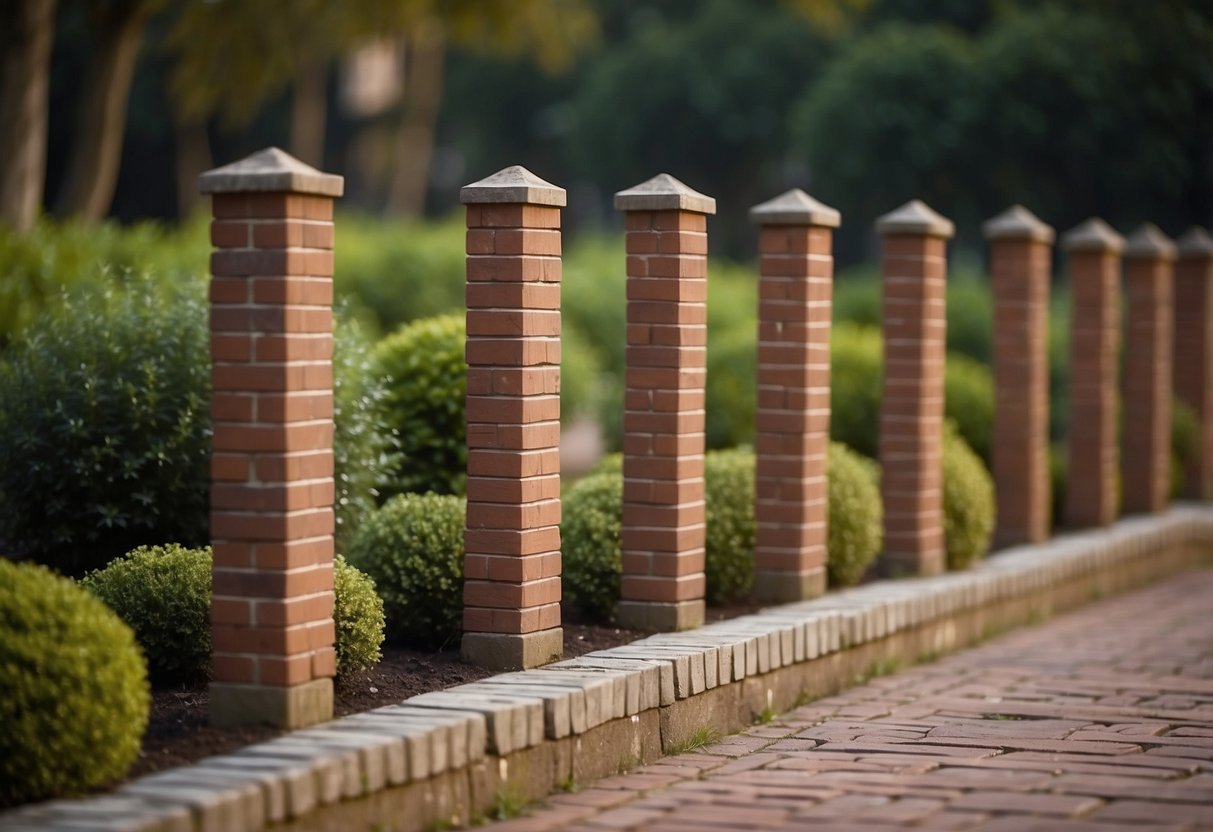Brick Garden Edging Ideas: Charming Ways to Define Your Space
Enhancing your garden with brick edging can bring both beauty and structure to your outdoor space. This classic and sturdy option not only helps define garden areas but also adds a touch of charm. Whether you’re looking for a traditional look or something more modern, brick edging offers a versatile solution for any garden style.

Want to know how to start with brick garden edging and create a polished look for your yard? Discover different ideas and methods that can help you achieve the perfect garden border. With a bit of effort and creativity, you can transform your garden into a well-organized and attractive space.
1) Classic Red Brick Border

Using a classic red brick border in your garden can add a timeless touch. It’s a great way to define your flower beds or pathways and give them a neat, polished look.
Red bricks are versatile and match various garden styles. You can lay them in a straight line or create gentle curves for added visual interest.
For a sturdy edge, dig a trench and fill it with a sand and cement mixture before setting the bricks. This helps keep them in place and ensures a long-lasting border.
2) Basket Weave Brick Pattern

The Basket Weave Brick Pattern is a charming and unique design for your garden edging. It interlocks horizontal and vertical bricks, creating a delightful geometric look.
This pattern is both attractive and functional. It stands out and brings a touch of elegance to your garden.
This design is also easy to maintain. Once set up, it requires minimal upkeep, making your garden look neat with little effort.
For more about the Basket Weave Pattern, visit Farm Food Family.
3) Brick and Gravel Mix

Combining bricks and gravel adds a stylish touch to your garden. Start by arranging the bricks neatly to create a clean border.
Next, fill the space behind the bricks with gravel. This provides a contrasting look that is both attractive and practical.
Using bricks with gravel is easy to maintain and gentle on your budget. It’s a creative way to enhance your garden’s appearance.
4) Herringbone Brick Design

A herringbone brick design adds an eye-catching pattern to your garden edge. It’s unique and stylish, making your garden stand out.
To lay this pattern, arrange bricks at right angles, creating a zigzag effect. It’s a bit more challenging than straight or diagonal designs, but it’s worth the effort.
For ease, start by laying out the pattern on a flat surface first, then transfer it to your garden edge. This can help you visualize the final look and ensure symmetry.
5) Curved Brick Edging

Curved brick edging makes your garden look stylish and neat. It’s not too hard to do and adds a unique shape to your garden beds.
To get started, lay out the shape you want using a garden hose. This gives you a guide for digging the trench.
Next, dig a trench along the hose line. Make sure the trench is even so the bricks stay level.
Once you have your trench, place the bricks in it, following the curve. Fill in any gaps with soil to keep the bricks in place.
For more details, check out this guide on curved brick garden borders.
6) Brick and Wood Combination

Mixing brick and wood can create a unique garden edge that stands out. You can use rustic wooden planks alongside sturdy bricks for a natural, charming look.
Lay the bricks first to form a solid base. Next, position the wooden planks vertically or horizontally.
This combo is visually appealing and durable. It adds warmth and texture to your garden space.
7) Brick Pillar Decorations

Brick pillars can add a stylish touch to your garden. They are perfect for creating a grand entrance or simply marking different sections of your garden. You only need a few bricks and some mortar to get started.
You can also use brick pillars to hold garden lights. This adds both beauty and functionality to your outdoor space. Check out more ideas for using brick pillars in your garden.
Another option is to top each pillar with a decorative item like a planter or statue. This can create a focal point and enhance your garden’s charm.
8) Brick Mosaic Steps

Brick mosaic steps can add a touch of charm to your garden. First, gather different-colored bricks to create your mosaic pattern. Decide on the design you want.
Next, dig out the area where your steps will be. Make sure each step is level.
Lay the bricks according to your pattern. Use mortar to secure them in place. Let the mortar dry. Your brick mosaic steps are now ready to be enjoyed.
9) Raised Brick Flower Beds

Raised brick flower beds give your garden a sophisticated look.
They provide excellent drainage and prevent soil erosion.
You can choose different brick colors to match your garden style.
Raised beds make planting and maintenance easier on your back.
Consider adding colorful flowers for a vibrant touch.
Adding lights around the edge can highlight your raised beds at night.
Raised beds also help keep pests away from your plants.
10) Brick and Stone Blend

Mixing bricks and stones in your garden edging adds a unique and natural feel. You can use red bricks combined with river stones for a charming look.
This method offers both durability and aesthetic appeal. You can arrange the stones and bricks in creative patterns to make your garden stand out.
Using bricks along the base and stones on top creates a layered effect. This combination works well with various garden styles and provides a visually appealing border. Get creative, and have fun experimenting with different layouts and materials.
Design Principles for Brick Garden Edging

Brick garden edging can greatly enhance the look of your garden by adding clear, attractive borders. Key design principles include picking the right brick style, coordinating colors with your garden, and creating smooth curved edges.
Choosing the Right Brick Style
The style of brick you choose can change the whole look of your garden. Traditional red bricks give a classic, warm feel. For a more rustic look, consider weathered or reclaimed bricks. If you prefer a sleek, modern vibe, opt for smooth, uniformly colored bricks.
Edge bricks can be laid flat for a subtle border or diagonally for a more decorative flair. Patterned bricks, such as herringbone or basket weave designs, add visual interest and can frame your garden beautifully. Think about the brick’s durability, especially if your garden experiences heavy foot traffic.
Color Coordination with Your Garden
Matching brick colors with your garden elements helps create a harmonious look. If you have a lot of green plants, red or brown bricks provide a nice contrast. For gardens with bright flowers, consider neutral or light-colored bricks to avoid overwhelming the space.
Take note of your home’s exterior color. If your house is brick, matching or coordinating your garden edging can tie the look together. For those with wood or stone exteriors, choose a complementary brick shade to ensure everything blends seamlessly.
Creating Curved Edges
Curved edges soften the look of your garden and can guide the eye around your outdoor space. To create curves, use small bricks that can be arranged easily, or cut larger bricks to fit the desired shape.
When laying curved brick edges, dig a shallow trench following the curve. Place the bricks snugly against each other, adjusting as needed to maintain the curve. Using concrete or mortar between bricks helps secure them and prevents shifting. Curved edges are especially useful for framing flower beds or pathways, creating a more organic feel.
Installation and Maintenance

Setting up brick garden edging is a rewarding project that involves a few clear steps: preparing the ground, laying the bricks, and ongoing care. This ensures a lasting and beautiful garden border.
Preparing the Ground
First, mark the area where you want to install the brick edging. Use stakes and string to outline the shape. This helps you see the layout and make adjustments.
Dig a trench along the marked outline. The trench should be slightly deeper than the thickness of the bricks to allow for a sturdy base. About 3 to 6 inches deep is often needed.
Create a solid base for the bricks by filling the trench with a mixture of sand and cement. A ratio of 4:1 (sand to cement) works well. Mix until it forms a thick paste and then spread it evenly in the trench with a trowel.
Laying the Bricks
Begin placing the bricks in the trench on top of the base. Put the bricks end to end or at an angle for a more decorative look.
Use a rubber mallet to gently tap each brick into place. This ensures they are firmly seated and level.
If necessary, cut bricks with a masonry saw or hammer and chisel to fit them at the ends of the trench. Make sure to transfer cutlines onto the face of the bricks for accurate cutting.
Backfill the trench around the bricks with soil or gravel. This helps keep them securely in place.
Long-Term Care Tips
To keep your brick edging looking good, be sure to check for any bricks that might shift or settle over time. Reposition them as needed.
Weed growth can become an issue. Keep the area around the bricks clear by pulling weeds regularly or using a weed barrier.
Avoid using harsh chemicals or high-pressure washers on your brick edging, as these can damage the bricks. Stick to gentle cleaning methods.
Inspect the mortar and sand base regularly. If any cracks appear, patch them to prevent further damage. Keeping an eye on this will help maintain the stability and appearance of your brick edging.
Inspiration and Ideas

Creating brick garden edging can bring a touch of charm and practicality to your outdoor spaces. By incorporating plants, mixing materials, and using reclaimed bricks, you can achieve a unique and beautiful garden design.
Incorporating Plants in Your Edging
Adding plants to your brick edging is a great way to blend natural beauty with structured design. Creeping thyme or succulents can be planted between the bricks. These low-growing plants will soften the edges and add color.
You can also create a raised bed with brick edging, allowing you to plant flowers or herbs right up to the edge. This approach not only enhances the visual appeal but also makes gardening easier by defining clear borders.
Consider using vining plants like ivy, which can weave through the bricks, adding texture. This combination not only looks great but also helps keep the soil in place and reduces erosion.
Mixing Materials for Unique Designs
Combining different materials with bricks can add a creative twist to your garden edging. For instance, try using a combination of bricks and gravel. First, lay your bricks in a neat border, then fill in behind them with gravel. This gives a nice contrast and is easy to maintain.
Another idea is to pair bricks with wooden elements like cedar. This offers visual interest and a natural look. Cedar is resistant to decay and insects, making it a durable option.
Using metal inserts between bricks can also create a modern look. Thin metal strips add a sleek and clean line, ideal for contemporary garden designs.
Using Reclaimed Bricks
Reclaimed bricks add character and history to your garden. They often come with a weathered look that new bricks can’t replicate. This makes them perfect for creating a rustic or vintage feel.
Start by cleaning the reclaimed bricks well to remove any moss or dirt. Then, arrange them in your desired pattern. Herringbone or basket weave patterns can bring a stylish touch to your borders.
Using reclaimed bricks is also an eco-friendly choice. You’re reusing materials and reducing waste, which is great for the environment. Plus, these bricks can often be found at a lower cost compared to new ones.
Find reclaimed bricks from local suppliers or salvage yards to keep the authenticity of your garden design intact.







